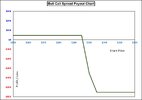- Joined
- 8 June 2008
- Posts
- 13,546
- Reactions
- 20,131
In a pure conservative way, if I want an insurance on let's say overexposure to PM, I could buy a short on a gold ETF.
Should I want to do that, I need to ensure I do not overpay for that option, and need to know the IV attached to a given option price.
How do I do that?
This is a pure novice question.
And I can do that on either ASX preferred as this would cover currency risk, or US market
Should I want to do that, I need to ensure I do not overpay for that option, and need to know the IV attached to a given option price.
How do I do that?
This is a pure novice question.
And I can do that on either ASX preferred as this would cover currency risk, or US market



